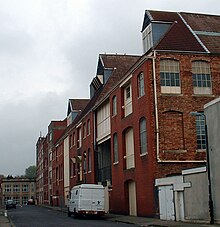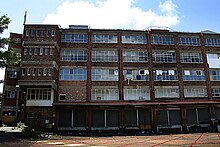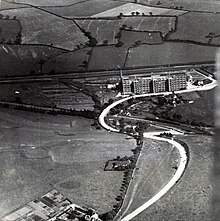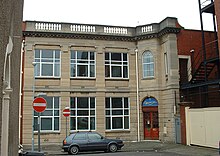Elizabeth Shaw (confectionery company)
 The Elizabeth Shaw chocolate factory on Co-operation Road | |
| Company type | Private |
|---|---|
| Industry | Confectionery |
| Founded | 1810 (Ewbanks) |
| Headquarters | Bristol,UK |
Key people | James Goldsmith,(chairman) |
| Products | Famous Brands & Elizabeth Shaw |
| Parent | Colian Holding |
Elizabeth Shaw Ltdis aBristol-based company owned byColian Holdingthat markets chocolate-based confectionery, including the brands Famous Namesliqueur chocolatesand Elizabeth ShawMint chocolates.The modern company was formed from several mergers of well established confectionery companies, first byJ A & P Hollandand then byJames Goldsmithin the 1960s as part of his creation of his food conglomerateCavenham Foods.
History of Ewbanks
[edit]In 1810, the business was founded by Thomas Firth as Firth Confectioners and wasPontefract's secondliquoricefactory, makingPontefract cakes.The business changed hands first to David Longstaffe, before coming under the partnership of Robert Ewbank and W. F. Horsell. The company moved to the larger Eagle Liquorice Works in 1887, but the partnership broke up in 1892 leaving Ewbanks solely in charge. The company became incorporated in 1912. The factory was damaged by incendiary bombs duringWorld War II,with a replacement being opened in 1948. The business was purchased by Hollands of Southport in January 1961 for £72,600.[1][2][3][4][5][6]The Eagle Liquorice Works were closed in 1965 after becoming part of Cavenham Confectionery.[7]
History of S. Parkinson & Sons
[edit]Doncaster's famous product wasbutterscotch,which is reputedly invented by Parkinsons in 1848. The company was founded by Samuel Parkinson, a grocer located on the High Street inDoncaster.The company first moved production to Station Road in 1905. The company advertised the butterscotch asRoyal Doncaster Butterscotchor theQueen's Sweetmeat.The company was purchased from the Parkinson family by Samuel Balmforth in 1892, before the business was incorporated in 1912 and moved to new premises inWheatley.At the time the company produced baking powder in addition to its liquorice products. By 1956 the company employed over 500 people and had expanded their range toParkinsons Boiled Sweets.In 1961 the company was purchased by Hollands of Southport.[1][8][9]
History of Yeatman & Co
[edit]Israel Edward Woolf established Yeatman & Co from 119 New Bond Street,Stepneyin 1857 selling Yeast powder, later opening a factory in Denmark Street and by 1884 they had diversified into Baking Powders; different flours; Callsayme Bitters; Lime-juice Cordial; Custard Powder; Egg Powders; Curry Powder; Flavouring Essences; Disinfecting Powder and Insect Powder. In 1899,Nursing Record & Hospital Worldstated that Yeatman's ginger marmalade and coffee extract tasted more of coffee than rivals' products. In 1898 the company was incorporated and had added further products to its range including soups, jams, jellies and sweets.Yeatman's Delicious Jelly Tabletswere exported to Australasia, and the company produced the first sweets forMarks & Spencer.Their factories in Stepney were destroyed by fire duringthe Blitz,and with government assistance, Yeatman's opened a new factory inWatford,where they made a more restricted line of canned and bottled fruit, fruit squashes, sweets (under theGoodiesandSelestabrands), and their best-remembered product,Sunny Spread.The business was sold to James Goldsmith's newly acquired business Carsons Ltd in 1964, and subsequently integrated into his Cavenham Foods business, with production being transferred and the factory being sold to Goldsmith's former company,Mothercare.[10][11][12][13]
History of H J Packer & Carsons
[edit]
The business was founded in 1881 by Edward Packer, in Armoury Square, Bristol. Packer was joined by his sister and brother. In 1884, the family took on, H. J. Burrows, thus becomingH. J. Packer & Co[14]but a year later the partnership was dissolved, and Burrows became the sole owner of the business. However, within a year Burrows had sold the business for £950 to Caleb Bruce Cole.[1]

The business sales increased greatly from 1894; so in 1901, the company moved to a new purposefully designed factory inGreenbank.The move coincided with continued growth and between 1903 and 1912, sales had grown by 250%, helped byTwo ounces per pennyquality chocolates aimed at children and popular lines likePackers Chocolate Mixers.In 1908 the company expanded by buying Glasgow-based high-end chocolate manufacturerCarsons,as well as the creation of the new brandBonds of Bristolto sell luxury chocolate products made at Greenbank. Carsons Glasgow factory was closed, and production was moved to a new factory in Shortwood, nearMangotsfield,Gloucestershire.The company by the early 1920s was Britain's 4th largest chocolate manufacturer and employed over 2000 employees, introducing new lines likeMilk Crispets.Carsons Chocolate was taken by SirErnest Shackletonand his team on their expeditions.[1][15][16]

However the company's fortunes declined by the start ofWorld War II,and by 1955 the company relaunched the Packers brand, bringing out new products includingSummitchocolate bars and penny sweets likeWhite MiceandSweet cigarettes.By 1961, Carsons' production was moved to Greenbank. Carsons was the biggest British manufacturer of chocolate liqueurs sold under theFamous Brandsname, and in 1962 H J Packer was renamed under Carsons Ltd. However the company was still not profitable and by 1963 it lost £39,000.[1]
The company fell prey ofJames Goldsmith,and became one of the founding businesses of his conglomerateCavenham Foodsin 1964.[1][14]
History of Walters Palm Toffee
[edit]
Walters Palm Toffeewas established by Nathan Baraf Walters, a naturalised Romanian immigrant, as a toffee factory inPoplar, Londonin 1887. The company's main product was so named as such as it used Palm butter in its manufacturing. The company moved to a larger factory inActon, Londonduring 1926, and was incorporated in 1928. By 1935 the company employed around 800 people, but the factory was destroyed by fire later that year but was rebuilt. In 1957, Nathan Walters died and left the business to four Jewish charities, a will that his four sons contested unsuccessfully. By 1960 the company was losing money, and a friendly takeover by J A & P Holland was secured.[17][18]
History of Fillerys Toffees
[edit]Fillerys Toffeeswas founded at Warwick Road, Birmingham by a consortium in 1923. The site expanded to four acres by 1927 and had moved to 24-hour production by 1930. The company was incorporated in 1934 and employed around 300 people. DuringWorld War IIthe factory moved over to munitions, with the company's products manufactured byRowntree'sunder license. The company's factory was very efficient and earned contracts for own brand products withWoolworthsandMarks & Spencer.The company saw a boom after sugar rationing was dropped in 1954, but later in the decade sales declined in the toffee market, and in 1960 Fillerys were bought by J A & P Holland.[19][20][21]
History of the original Elizabeth Shaw company
[edit]Elizabeth Joice and her husband Patrick, started a cottage confectionery business making honeycomb mint-flavoured crisps in 1937, named after Elizabeth and taking Shaw from her former employer Page & Shaw.[22]They were soon marketed asMint Crispsand by 1939 a new factory inBrentfordwas opened called Mint House. The business continued to grow offering new products including Mint Creams. However the business was damaged by fire in 1953, and the Joice's had to sell the company and production was moved to a factory inCamberley.However the new factory also fell to a devastating fire in 1968, and the business was purchased byCavenham Foodsand production moved to Greenbank.[22][1]
History of Hollands of Southport
[edit]In the 1890s John Holland developed a new way to produce creamy toffee from premises at 23a Cross Street, Southport that had been given to him by his uncle James Ford. Holland had completed an apprenticeship with Ford, a confectioner inOrmskirk.Holland's best-selling product was Everton Toffee. The company opened a new factory at Virginia Street duringWorld War I,and in 1927 John Arthur Holland became manager at the factory, with the business trading asJohn Holland & Sonfrom 1932. John Arthur Holland took charge of the business from 1936, introducing the brand promiseBest on Earth.A fire damaged the doctors in 1940, but afterWorld War IIthe company expanded, exporting to the United States for the first time in 1953. A year before in 1952 John Arthur's sons, John Arthur Junior and Peter took charge of the business and the company changed its nameJ A & P Holland.[4]
The company floated on the Liverpool Stock Exchange in 1953, and a year later an extension was added to the Virginia Street factory. The toffee market had started to decline, and the brothers believed they should expand by purchasing rivals.[23]Their first major purchase wasCoq D'or Chocolatesin 1959.[24]This was followed up byFillerys Toffeesin 1960, a high-end toffee manufacturer who had contracts withMarks & Spencer,which was closely followed byCasket Confectioneryand London basedWalters Palm Toffeefor £385,000.[4][25][24]Later that year the company was listed on theLondon Stock Exchangeand the company had taken over 20 firms. The company continued to expand during 1961, purchasingS. Parkinson & Son,Harper Paperfor £1.25 million,Mackay Brothers (Confectioners)ofEdinburghandGeorge & Son(confectioners and wholesalers) ofSouthend-on-Seaamongst other.[4][26]TheDaily Mailcalled Holland the world's biggest toffee manufacturer,[27][28]and by 1965 it controlled 33 wholesaling warehouses.[29]
John Arthur Holland Junior invented a soft toffee in 1963, which was launched asChewzits(later relaunched by Cavenham asChewits). However the company did not pay out a dividend in 1963 or 1964, with many of its subsidiaries struggling. The company's independent shareholders were in disagreement with the Holland family, and in 1965James Goldsmith's Cavenham Foods staged a takeover bid which the Holland family fought but lost.[4][30]
Cavenham Confectionery Ltd
[edit]Carsonswas joined byYeatmans,makers of sweet brands Goodies and Selesta,J A & P Holland,Britain's biggest toffee manufacturer, andParamount Laboratories,makers ofCadet Sweetsweet cigarettes, to form theCavenham Confectioneryarm ofCavenham Foods.[1][14]As well asFamous Names,the new company's other products includedChewits,Hollands Toffee,Fillery's Toffee,Walters Palm Toffee,Ewbanks Liquorice,Dr Who & The Daleks Sweet Cigarettes,Royal Doncaster ButterscotchandParkinsons Boiled Sweets.[31][4][32]The new company closed many of the factories of its subsidiaries, concentrating production at Carsons' Greenbank site, Holland'sSouthportlocation and Parkinsons'Doncasterfactory.[33][34][35]
In 1967, withCavenham Foodsin financial difficulty, James Goldsmith merged Cavenham Confectionery into a 50/50 partnership withPerrier's confectionery business which included the brandsMenierandLindt.[36][37][38]The business exported $750,000 of goods to America in 1968[34]and purchased the brand and recipes of Elizabeth Shaw. The partnership with Perrier was dissolved in 1969, and Cavenham Confectionery was sold toConwood SAfor £1.2 million, a company owned 50/50 by Cavenham Foods andConwood Corporation,but was soon sold back to Cavenham Foods.[39][40]In 1981, the management of Cavenham Confectionery purchased the business as part of James Goldsmith's breakup of Cavenham Foods for £8 million. The business name was changed toFamous Names Ltd.[1][41]
Famous Names Ltd to Elizabeth Shaw Ltd
[edit]The business at the time of its purchase by the management team had 44% of the UK's chocolate liqueurs market and 50% of the chocolate mint trade.[42]The business was purchased by conglomerateImperial Groupin 1985 but was again purchased by its management in 1988, after divestment of business by new ownersHanson Trust plc,and renamed the businessElizabeth Shaw Ltdwith the Famous Brands name dropped. The business was again sold in 1990 to Finnish confectionery businessLeaf.[42][1][43]
In March 2006 Elizabeth Shaw's chocolate business was purchased byNói Síríus,the largest confectionery manufacturer inIceland.[44]In 2006, faced with the high costs associated with the 330,000 sq feet building, the company relocated its manufacturing to factories in the UK and in mainland Europe, and closed the then 105-year-old factory. The business was subsequently purchased by a Norwegian company, Imagine Capital in 2009.[45][46]In 2016,Colian Holding,Poland's largest confectionery manufacturer, acquired Elizabeth Shaw from Imagine Capital.[47]
Greenbank factory site
[edit]
In 2013 local residents successfully argued against redevelopment of the closed factory into flats and houses.[48]The building, in the eyes of local residents, represented part of the industrial heritage of Bristol. The opposition to this redevelopment was supported byGeorge Ferguson,whose vision had earlier turned a defunct tobacco factory in Bedminster into one of Bristol's leading artistic and creative venues, called theTobacco Factory.However, as of 2012, the building was still standing empty, following the failure of all the parties involved to deliver an acceptable and workable solution for the future use of the building and site.[49]By late 2013 the building had reverted to theClydesdale Bankand developments were being planned by the Generator Group. More information is held on the current community group website for the chocolate factory (External Links below). In August 2014, the site's new owners Generator South West look likely to proceed with a new project after holding a public meeting to understand local residents' opinions. The plan is to create open spaces around a development of flats and housing.[50]
As of 2016 there have been many problems surrounding the development of this site, namely that developers Generator South West "have asked to be excused from the legal obligation that between 30 and 40 per cent of any development be social housing, on the basis that the extra costs of restoring old, historic buildings makes the plan economically unviable."[51][52]
Community action group ACORN are one of the groups campaigning against this back-tracking on the provision of social housing due to the current housing crisis in Bristol and severe lack of social or affordable housing being built. Developers Generator Group worked with Bristol City Council to ensure that 36 shared ownership homes were created alongside the private housing. The first homes to be built for occupation in 2021 are shared ownership.[53]
Archives
[edit]Records of Elizabeth Shaw Limited, primarily relating to the Greenbank factory, are held atBristol Archives.The collection also includes some records of HJ Packers, Carsons Ltd, Cavenham Confectionary Ltd,United Biscuits,Hollands Toffees, andHuhtamäkiamongst others which are linked with Elizabeth Shaw Limited (Ref. 43258) (online catalogue).[14]
References
[edit]- ^abcdefghijChrystal. P (2021).The History of Sweets.pp. 133–134.ISBN978-1-5267-7888-8.
- ^"Item number: P1996.361".Wakefield Council Museum Department.Retrieved18 June2023.
- ^"Item number: P1996.782".Wakefield Council Museum Department.Retrieved18 June2023.
- ^abcdef"Just Chewit: Holland of Southport".Let's Look Again.Retrieved18 June2023.
- ^"Ewbanks Ltd".The Pharmaceutical Journal and Pharmacist.90:851. 1913.
- ^Chrystal. P (2021).The History of Sweets.pp. 78–79.ISBN978-1-5267-7888-8.
- ^"View from Britain".CI: Candy Industry and Confectioners Journal.125:59. 1965.
- ^"S. PARKINSON AND SON (DONCASTER) LIMITED, MANUFACTURING CONFECTIONERS".National Archives.Retrieved18 June2023.
- ^Chrystal. P (2019).Doncaster at Work. People and Industries Through the Years.ISBN978-1-4456-8592-2.
- ^"Ratcliff(e) Highway (later St George's Street / now The Highway) and streets off".George in the East Church.Retrieved19 June2023.
- ^"Drinks and how to make them by Yeatman- & Co".Vintage Cocktail Books.Retrieved19 June2023.
- ^"Sunny Spread".History World.Retrieved19 June2023.
- ^"Yeatman's household preparations, 1883".British Library Collections.Retrieved19 June2023.
- ^abcd"Records of HJ Packer & Co, Carsons Ltd and Elizabeth Shaw Limited, chocolate manufacturers, 1886 - 2006".Bristol Archives.Retrieved18 June2023.
- ^Charles Allen Oakley (1937).A Survey of Recent Development Undertaken for the Scottish Development Council.Scottish Industry To-day(Report). p. 222.
- ^"Letters".The Medical Officer - A Journal for Medical Men in the Government and Municipal Services.26:222. 1921.
- ^"Walters Palm Toffee".Let's Look Again.Retrieved18 June2023.
- ^"J A & P Holland".The Economist.Vol. 197. 1960. p. 272.
- ^"Fillerys Toffees of Birmingham".Let's Look Again.Retrieved18 June2023.
- ^Burg. J (1997).A Guide to the Rowntree and Mackintosh Company Archives, 1862-1969.p. 141.ISBN978-0-903857-62-8.
- ^"Further new £40,000 factory in Birmingham buildings".Business.Vol. 85. 1955. p. 58.
- ^ab"The Chocolate Factory History".The Chocolate Factory.Retrieved18 June2023.
- ^"J A & P Holland".Investors Chronicle and Money Market Review.Vol. 214. 1961. p. 970.
- ^ab"J A & P Holland".Investors Chronicle and Money Market Review.Vol. 214. 1961. p. 970.
- ^"Confectionery".Commerce & Industry.Vol. 20. 1961. p. 556.
- ^"More acquisitions by J A & P Holland".Food Processing & Marketing.Vol. 30. 1930. p. 433.
- ^Mennell. W (1962).Takeover: The Growth of Monopoly in Britain, 1951-61.p. 160.
- ^"Hollands of Southport".CI: Candy Industry and Confectioners Journal.116–117: 26. 1961.
- ^"View from Britain & the Continent".CI:Candy Industry and Confectioners Journal.125:14. 1965.
- ^Fallon. I (1991).Billionaire. The Life & Times of Sir James Goldsmith.p. 159.ISBN0-09-174380-X.
- ^"Cavenham Foods".Jane's Major Companies of Europe.1977. p. B-89.ISBN978-0-531-03264-0.
- ^George Mann; Justin Richards; Cavan Scott (2017).Doctor Who: Dalek The Astounding Untold History of the Greatest Enemies of the Universe.ISBN978-1-4735-3082-9.
- ^"Cavenham Foods".Investors Chronicle.Vol. 9. 1969. p. 349.
- ^ab"Cavenham Confectionery Success in America".Anglo American Trade News.Vol. 6. 1967. p. 37.
- ^"US International".Vend.Vol. 23. 1969. p. 46.
- ^Fallon. I (1991).Billionaire. The Life and Times of Sir James Goldsmith.p. 170.ISBN0-09-174380-X.
- ^"Finance and Commerce".The Accountant.158:21. 1968.
- ^"The Big Time for Cavenham".The Times.7 March 1967.
- ^"Cavenham Foods".Management Today.1972. p. 111.
- ^"Cavenham Foods".Investors Chronicle.Vol. 9. 1969. p. 1187.
- ^"Personal".Food Processing Industry.Vol. 51. 1982. p. 17.
- ^ab"H J Packers of Bristol".Let's Look Again.Retrieved18 June2023.
- ^"Southport's Chewits factory".Liverpool Echo.1 June 2015.
- ^Gudmundsson, Haraldur (16 April 2014)."Seldu 434 tonn af sælgæti til átta landa"[434 tons of candy sold to eight countries].Vísir.is(in Icelandic).Retrieved4 December2019.
- ^Chocolate maker goes to Iceland,Europe Intelligence Wire, 4 March 2006
- ^A Sweet Friend of the Icelandic people; Nói Síríus expands beyond domestic shores Vol. 2 3-2006 page 13 October I&I (Issues and Images Iceland) magazine
- ^"Colian Holding przejął znanego brytyjskiego producenta słodyczy".money.pl.28 April 2016.
- ^"Developer's plans for Bristol chocolate factory".This is Bristol.17 September 2008. Archived fromthe originalon 5 May 2013.Retrieved28 April2013.
- ^"School planned at former factory".This is Bristol.10 December 2012. Archived fromthe originalon 5 May 2013.Retrieved28 April2013.
- ^Michael Ribbeck (7 August 2014)."Hope for Bristol's Elizabeth Shaw factory site transformation".Bristol Post.Archived fromthe originalon 22 December 2015.Retrieved26 January2017.
- ^Tristan Cork (4 November 2016)."We can't provide social housing, say Bristol chocolate factory developers, we're already giving £1m".Bristol Post.Retrieved26 January2017.[permanent dead link]
- ^Ian Onions (25 November 2016)."Chocolate factory site in Bristol 'not viable' for affordable homes, say council's planning officers".Bristol Post.Archived fromthe originalon 26 November 2016.Retrieved26 January2017.
- ^"Developers work with Bristol Council to bring The Chocolate Factory to life | Business Leader News".Business Leader.5 March 2020.Retrieved22 August2021.
External links
[edit]- Elizabeth Shaw's web page(History page (archived 2011))
- A Short History of the Greenbank Chocolate Factory,John Penny (archived 2016)
- Greenbank Factory,Chocolate Memories (archived 2011)
- Packer's to LEAF (UK) 1881 – 1991, A Short History of Chocolate Making in Greenbank, Bristol,Living Easton
- Elizabeth Shaw Chocolate Factory, Bristol,Whatever's Left, 6 December 2009
- Website for the new community group, ChocBox2 with further news of developments on the site
- Website for the proposed development by Generator South West
- Records of HJ Packer & Co, Carsons Ltd and Elizabeth Shaw Limited
